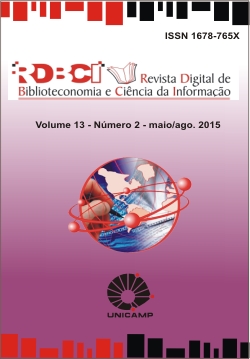Abstract
This article demonstrate the experience in the application of Card Sorting technical ́s at the classroom, in a context of two courses of undergraduate Library Science, School of Information Science at the Federal University of Minas Gerais: Conceptual modeling based on the principles Ranganathan and Information Architecture and Digital Accessibility. The contributions of categorization were used in the context of Information Organization, highlighting elements that support the discussion on the design of the Card Sorting. It was noticed that are essential understanding and mastery of the aforementioned technique for information professionals will engage in treatment, categorizing and organizing information into digital information environments but also in structuring the navigational flow of these environments. From the point of view of the teaching of Library and Information Science, experience has shown the potential for interdisciplinary practice in the implementation of integrative work and partnership between different disciplines.
References
ALVARENGA, L. Representação do conhecimento na perspectiva da ciência da informação em tempo e espaços digitais. Encontros Bibli: revista eletrônica de Biblioteconomia e Ciência da Informação, Florianópolis, v. 8, n. 15, p. 18-40, 2003.
CAMPOS, M. L. de A.; GOMES, H. E. Organização de domínios de conhecimento e os princípios ranganathianos. Perspectivas em Ciência da Informação, Belo Horizonte, v. 8, n. 2, p. 150-163, jul./dez. 2003.
COLL, C. et al. Os conteúdos na reforma: ensino e aprendizagem de conceitos, procedimentos e atitudes. Porto Alegre, RS: Artmed, 2000, 182 p.
CYBIS, W.; BETIOL, A. H.; FAUST, R. Ergonomia e usabilidade: conhecimentos, métodos e aplicações. São Paulo: Novatec Editora. 2007.
DAVIES, R. Hierarchical Card Sorting: a tool for qualitative research. Disponível em: < http://www.mande.co.uk/docs/hierarch.htm>. Acesso em: 18 jun.2014.
FARIA, M. M. de. Card Sorting: noções sobre a técnica para teste e desenvolvimento de categorizações e vocabulários. Revista Digital de Biblioteconomia e Ciência da Informação, Campinas, v.7, n.2, p.1-9, jan./jun. 2010.
GRAHAM, I. UML Tutorial. 2007. Disponível em: < http://uml-tutorials.trireme.com/>. Acesso em: 16 jun. 2014.
HUDSON, W. Card Sorting. In: SOEGAARD, M.; DAM, R. F. (Ed.). The Encyclopedia of Human-Computer Interaction. 2nd ed. Aarhus, Denmark: The Interaction Design Foundation, 2013. Disponível em: < http://www.interaction-design.org/encyclopedia/card_sorting.html>. Acesso em: 10 maio 2014.
NIELSEN, J. Card Sorting: how many users to test. 2004. Disponível em: < http://www.useit.com/alertbox/20040719.html>. Acesso em: 16 jun. 2014.
ORTEGA, C. D. Contexto de desenvolvimento da Organização da Informação, com enfoque para a Catalogação.Perspectivas em Ciência da Informação, v.18, n.2, p.182-215, abr./jun. 2013.
PADOVANI, S.; RIBEIRO, M. A. Card Sorting: adaptação da técnica para aplicação ao design de sistemas de informação não digitais. Revista Brasileira de Design da Informação , São Paulo, v. 10, n. 3, p. 293 - 312, 2013.
ROCHA, Janicy Aparecida Pereira; SOLANO, Viviane de Oliveira. 2014. Altura: 1024 pixels. Largura: 768 pixels. 300 dpi. 32 BIT CMYK. 1,36 Mb. Formato PNG. Registros de sala de aula.
RODRIGUES, M. E. F.; CAMPELLO, B. S. (Org.) A (re) significação do processo de ensino/aprendizagem em Biblioteconomia e Ciência da Informação: novas abordagens didático-pedagógicas. Niterói, RJ: Intertexto; Rio de Janeiro: Interciência, 2004. 142p.
ROSENFELD, L.; MORVILLE, P. Information Architecture for the World Wide Web. 3ed. Sebastopol: O'Reilly, 2006. 528 p.
SÁ, M. I. da F. e. O ensino da disciplina de arquitetura de informação: uma aplicação da técnica de Card Sorting. In: CONGRESSO BRASILEIRO DE BIBLIOTECONOMIA,
DOCUMENTO E CIÊNCIA DA INFORMAÇÃO, 25, 2013, Florianópolis. Anais... Florianópolis: FEBAB, 2013. Disponível em: < http://portal.febab.org.br/anais/article/view/1475>. Acesso em: 10 maio 2014.
SANTA ROSA, G.; MORAES, A. de. Design participativo. Rio de Janeiro: Rio Books, 2012. 169 p.
SILVA, A. da; LIMA, G. Revista Interamericana de Bibliotecología. Medellín (Colômbia), v. 34, n. 3, p. 301-312, 2011.
UNIVERSIDADE FEDERAL DE MINAS GERAIS. Programa de Pós-Graduação em Ciência da Informação. PPGCI/UFMG. Resolução n. 05 de 20 de setembro de 2013. Regulamenta o estágio docente de alunos vinculados ao PPGCI/UFMG. Disponível em < http://ppgci.eci.ufmg.br/o-programa/resolucoes/resolucao-no-03-2013-estagio-docente.pdf/at_download/file>. Acesso em: 01 jun. 2014.
VILELA, R. S. de S., CARVALHO, K. M. de, FAGUNDES, F. Utilização do Card Sorting na implementação de um sistema de Balanced Scorecard para instituições de ensino superior. In: ENCONTRO DE ESTUDANTES DE INFORMÁTICA DO TOCANTINS, 11., 2009, Palmas. Anais... Palmas: Centro Universitário Luterano de Palmas, 2009. p. 233-243. Disponível em: < http://www3.ulbra-to.br/eventos/encoinfo/2009/Anais/Utilizacao_do_Card_Sorting_na_Implementacao_de_um_Sistema_de_Balanced_Scorecard_para_Instituicoes_de_Ensino_Superior.pdf >. Acesso em: 6 jun. 2014

RDBCI: Revista Digital de Biblitoeconomia e Ciência da Informação / Digital Journal of Library and Information Science uses the Creative Commons (CC) license, thus preserving the integrity of articles in an open access environment, in which:
- This publication reserves the right to modify the original, regarding norms, spelling and grammar, in order to maintain the standards of the language, still respecting author writing style;
- The original documents will not be returned to the authors;
- Published works become Revista Digital de Biblitoeconomia e Ciência da Informação / Digital Journal of Library and Information Science's property, their second partial or full print being subject to expressed authorization by RDBCI's editor;
- The original source of publicaton must be provided at all times;
- The authors are solely responsible fo the views expressed within the document.





